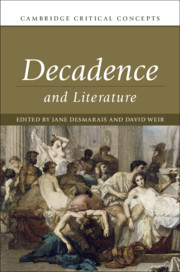Book contents
- Decadence and Literature
- Cambridge Critical Concepts
- Decadence and Literature
- Copyright page
- Dedication
- Contents
- Figures
- Contributors
- Acknowledgements
- Introduction
- Part I Origins
- Part II Developments
- Part III Applications
- Chapter 16 Decadence and Urban Geography
- Chapter 17 Socio-aesthetic Histories: Vienna 1900 and Weimar Berlin
- Chapter 18 Decadence and Cinema
- Chapter 19 Transnational Decadence
- Chapter 20 Decadence and Modernism
- Chapter 21 Modern Prophetic Poetry and the Decadence of Empires: From Kipling to Auden
- Chapter 22 The Gender of Decadence: Paris-Lesbos from the Fin de Siècle to the Interwar Era
- Chapter 23 Decadence and Popular Culture
- Select Bibliography
- Index
- References
Chapter 20 - Decadence and Modernism
from Part III - Applications
Published online by Cambridge University Press: 12 August 2019
- Decadence and Literature
- Cambridge Critical Concepts
- Decadence and Literature
- Copyright page
- Dedication
- Contents
- Figures
- Contributors
- Acknowledgements
- Introduction
- Part I Origins
- Part II Developments
- Part III Applications
- Chapter 16 Decadence and Urban Geography
- Chapter 17 Socio-aesthetic Histories: Vienna 1900 and Weimar Berlin
- Chapter 18 Decadence and Cinema
- Chapter 19 Transnational Decadence
- Chapter 20 Decadence and Modernism
- Chapter 21 Modern Prophetic Poetry and the Decadence of Empires: From Kipling to Auden
- Chapter 22 The Gender of Decadence: Paris-Lesbos from the Fin de Siècle to the Interwar Era
- Chapter 23 Decadence and Popular Culture
- Select Bibliography
- Index
- References
Summary
The centrality of decadence to the development of modernism is clear in the work of the major modernist figures James Joyce, Marcel Proust, and Thomas Mann. Joyce expatiates on decadent traits with such encyclopaedic abandon in the ‘Circe’ chapter of Ulysses that they finally evince something absurd and mysterious in human nature, whereas in In Search of Lost Time Proust more tightly aligns decadent traits with the burden of personal character and societal malaise. Mann, in underscoring both medical and metaphysical aspects of decadence, links with Joyce and Proust at many points. These prominent modernists reflect awareness of two basic polarities that first emerged in the decadent era of the fin de siècle: on the one side, concern over disintegrative forces in the modern world and realization of the need to take spiritual and aesthetic shelter; and, on the other, a sense of the aesthetic imperative to harvest the gains which the opportunity of such a moment presented.
- Type
- Chapter
- Information
- Decadence and Literature , pp. 332 - 346Publisher: Cambridge University PressPrint publication year: 2019



